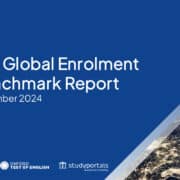New Zealand showing strong growth in international enrolment again this year
The latest data from Immigration New Zealand (INZ) affirms that the country remains on course for another strong year of growth in 2015. Following a 13% year-over-year increase in international enrolment between 2013 and 2014, year-to-date (YTD) figures through September 2015 indicate a 12% increase in total student visas compared to the same period from last year. As always, two important caveats apply when considering trends based on student visa data:
- The number of visas issued does not precisely correspond to actual enrolment as there may be a lag of some months between the time the visa is received and the student’s actual attendance.
- Students enrolled in courses of less than three months do not require a study visa. This means the student visa figures generally understate enrolment in any Private Training Establishments (PTEs), including language schools, offering shorter-term programmes.
With those factors in mind, there are nevertheless two broad observations that can be made of the latest INZ data. First, the overall pattern of enrolment throughout the year remains quite consistent in 2015, relative to that of the previous three years. (Please see the chart below for further details.)
Second, the number of student visas issued is up consistently this year - by 12% in all cases - for returning students, first-time arrivals, and, correspondingly, for total student visas issued as well. This reflects, at this advanced stage in the year, that New Zealand’s institutions and schools have achieved consistent growth in both the cumulative base of returning students as well as new student arrivals for the past two years.

- Institutions and schools in Auckland account for 64% of all student visas issued this year. With that strong base to build on, it is perhaps not surprising that the region is also home to much of the growth in student numbers this year. The 12% increase in enrolment equates to 7,922 more students in institutions and schools throughout the country. However, nearly three-quarters of that increase (73.43% or 5,817 students) is concentrated in Auckland.
- Many regions of the country have experienced greater growth in percentage terms but none approach Auckland’s growth in head count enrolment. Canterbury, for example, is a distant second among student destinations within the country. It matches Auckland’s 14% growth YTD September, but in Canterbury’s case this translated to an additional 790 students (just about 10% of the total YTD growth for New Zealand) compared to the same period in 2014.
- As noted earlier, actual PTE enrolment tends to be understated in the visa data but even so, the INZ figures show strong growth in PTE student numbers this year. Indeed, all sectors of the New Zealand system have seen growth YTD September, with the exception of Intermediate schools. PTEs are again starting from a strong base this year, and account for about 40% of all student visas issued by New Zealand (as compared to 30% for universities and 14% for schools).

- China and India are the major drivers of growth again this year. Of the 7,922 additional student visas issued YTD September, more than 83% are for either Chinese or Indian students. China has sent 3,181 more students so far this year (an increase of 15% compared to the same period in 2014), and India a further 3,426 (25% more than last year). Only the Philippines, with 939 additional students (a 93% increase over 2014), comes close to these top-performing sending markets in New Zealand’s latest visa data.
- Chinese enrolments tend to be distributed across all sectors but skew towards the universities and Institutes of Technology and Polytechnics (ITPs). Indian students, in contrast, are more sharply concentrated in ITP and PTE programmes. The potential risk associated with such concentrated enrolment is seen in this year’s Intermediate school numbers. Korean students account for more than half (55%) of Intermediate school enrolment in New Zealand, and weakening demand in the Korean market generally is helping to push overall Intermediate numbers down this year.
- The new regional data from ENZ also helps to illustrate why Auckland is such an important centre in New Zealand for international students. It is home to more than half of the country’s international university students, just under half of international ITP students, and eight out of ten international PTE students.
Sector in focus
These impressive gains have helped to put New Zealand’s international education sector further in the spotlight this year: international education is one of the seven priority export sectors established in a Business Growth Agenda launched by the New Zealand government last month. The sector contributed NZ$2.85 billion (US$1.85 billion) to the national economy last year, and supported more than 30,000 jobs across the country. The new Business Growth Agenda sets out a number of strategies designed to both support the sector and increase its economic impact at home. These range from a renewed emphasis on outbound mobility, language learning, and building alumni networks to an expansion of scholarship programmes for international students and a strengthening of international branding efforts. The government has also announced additional targeted support to build international enrolment in regions across the country. Tertiary Education, Skills and Employment Minister Steven Joyce has established a NZ$2.76 million fund for new initiatives in the regions – that is, outside of Auckland. The bulk of the new funding (NZ$2 million) will be distributed via ENZ’s Regional Partnership Programme, an initiative that "provides support and co-funding for a range of activities focused on regional international education industries." "The additional funding will also focus on market diversification, exploring new education partnerships, particularly in countries like Colombia and the Philippines around the Asia-Pacific region that have the potential to become significant international education markets for New Zealand," notes an official release. "Activity will also be stepped up in markets where New Zealand has existing educational ties, including Vietnam and the United States."














